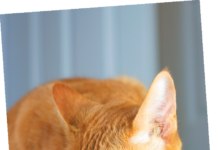Many of us maintain a little stockpile of our favorite snacks in a cupboard somewhere. And plenty of pet owners feel that their beloved four-legged companions deserve their own stash of treats as well. But does the habit of giving treats actually benefit our cats — or is it more a matter of anthropomorphism than anything else?
“Cats don’t require treats,” says Cailin Heinze, MS, VMD, assistant professor of nutrition in the Department of Clinical Sciences at Tufts Cummings School of Veterinary Medicine. “But they can be appropriate if your cat is healthy and you watch the calories. Some owners give treats to cats — but it’s less common than with dogs. But that’s probably because it’s less common to train a cat than a dog.”
Training is actually a great reason to introduce treats to your cat, she says. While it’s tempting to toss your feline a treat because she looks so cute curled up on the couch, “the best use of treats is as a reward for good behavior — specific good behavior,” says Dr. Heinze.
“If you want your cat to come when you call her, or to sit, or not to be in your face when you eat your cereal in the morning, you can train you cat. Food that is not in a bowl can be a powerful motivator,” explains Dr. Heinze. “It’s amazing what cats can be trained to do with positive rewards, and treats are one easy way to reward them. It takes a little more patience than with dogs — you have to convince them that it’s in their own best interest.” (See related article on clicker training on page 10 of this issue.)
Even if you just want to give your cat an occasional treat for doing nothing in particular, you should choose treats — either store-bought or homemade — that are safe, nutritious and integrated into an overall diet.
What To Look For In a Treat
Different cats like different treats, so you may need to experiment to find one that your cat loves. “If the manufacturer has good quality control, and the treat is fully cooked and low in calories, there’s a lot of flexibility in what you can choose,” says Dr. Heinze. “Most commercial treats, fed in small amounts to healthy cats, are unlikely to cause harm.”
Because treats should only make up a small part of the daily diet, there’s no reason to chase after specific nutrients such as copper or iron. But calories do count. If calories aren’t listed on the label, you should call the manufacturer and ask them about calorie information, suggests Dr. Heinze. “If they can’t provide it, choose another.”
Even for a normal-weight cat, calories from treats should make up no more than about 10 percent of the total daily caloric intake. If your cat weighs eight to 10 pounds, she may need only 200 to 250 calories a day — so her treats should make up only 20 or 25 calories a day. “Yet even the smallest commercial treats are usually three or four calories a piece,” notes Heinze. “Owners often underestimate, or ignore, calories that come from treats.” (See sidebar on below.)
So you should make treats special — and occasional. What matters most is portion control. That’s especially true if your cat is overweight. “Obesity is quite a big problem, with one half to two thirds of cats being overweight or obese,” explains Dr. Heinze. “Cats are designed to eat small amounts frequently, with lots of exercise in between. In our environments they don’t get a lot of exercise catching what they eat. If your cat is overweight, treats can make things worse.”
What you should avoid
While there’s no need to search for specific nutrients when buying a commercial treat, there are some things to avoid. “Don’t feed your cat raw treats,” says Dr. Heinze. “Even freeze-dried raw treats can cause food-associated illness, such as campylobacter or salmonella.”
Sugar is another ingredient to skip. “Cats don’t taste sugar, like dogs do, so it has little benefit to a cat,” says Dr. Heinze. “Nothing in the natural diet of wild cats is sweet — not mice, not shrews, not snakes.”
Also, dog treats should not be given to cats. “There may be ingredients in dog treats that aren’t safe for cats,” explains Dr. Heinze. “For example, ethylene glycol —the main ingredient in antifreeze — is sometimes added to dog foods in small amounts to keep it moist. The quantities aren’t a problem for dogs, but could be dangerous for cats.”
Homemade Treats
“I use meats from my kitchen when I’m training my cat,” says Dr. Heinze. “I used small cut-up bits of chicken breast, or pork loin – tiny little pieces. I always use cooked meat. These make nice treats for healthy cats.”
If you’re tempted to make homemade treats, you should beware of certain potentially dangerous ingredients:
Onions and garlic. “Onions are more of a concern than garlic, but both are potentially problematic. They cause oxidative damage to blood cells in cats.” All types of onions, including green onions (scallions) and shallots, should be avoided.
Processed meats. Simple cooked chicken is one thing, but avoid lunch meats, deli meats, rotisserie chicken and other processed meats for cats. They’re high in fat and sodium.
Baby food. “Some people give their cats meat-flavored baby food,” says Dr. Heinze. That may be safe in very small amounts, “but some are flavored with onion or garlic powder, so they can be a problem.” Check the labels.
Special Diets
“If your cat is on a diet for health reasons, always talk to your veterinarian so she knows what your treats are, and if they are appropriate,” says Dr. Heinze. “For example, if you have a cat with heart disease, you should check into the amount of sodium in the treat. If your cat has kidney disease, you likely will need to avoid meat treats, because they tend to be too high in protein and phosphorus.”
Some cats can also have food allergies. “Food allergies actually aren’t that common in animals, but if your cat is allergic to chicken, you’re not going to want to give that cat a chicken treat,” explains Dr. Heinze.
Age alone isn’t really a factor in whether to feed treats. “You may have a 19-year-old cat with no health problems, and treats are fine,” she says. “Or you may have a three-year-old cat with health problems on a special diet, who needs special treats — or no treats at all.”
A Place for Treats
“Providing occasional treats can make your relationship with your cat better,” says Dr. Heinze. That’s especially true if you use treats to teach your cat good behavior. Even kittens can learn. “If you’re training your kitten, that’s a good time to introduce treats in limited amounts.”
What if you don’t want to start the treat habit for your cat? That’s fine, too. “There’s no reason cats need treats,” says Dr. Heinze. “If you never teach your cat that treats exist, you don’t have to worry about her begging for them.” — Bob Barnett



